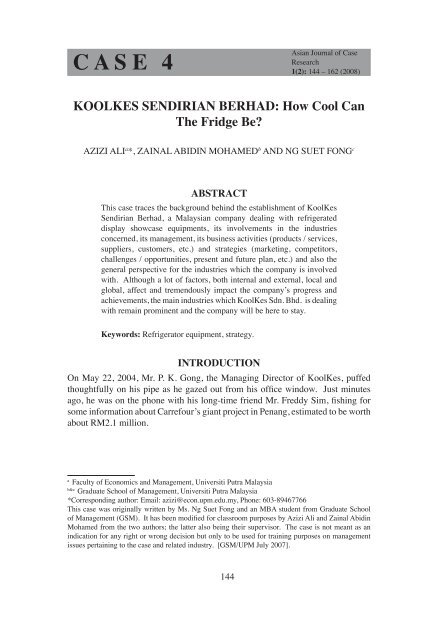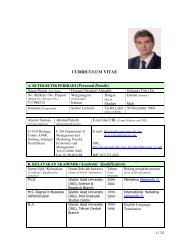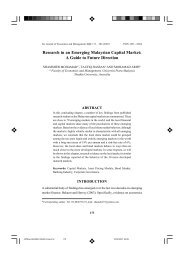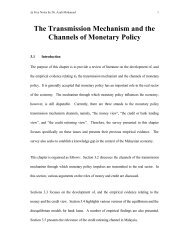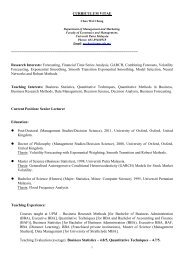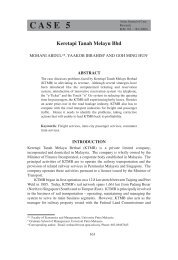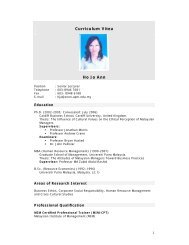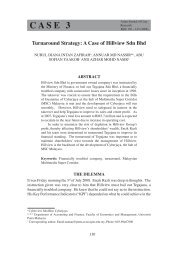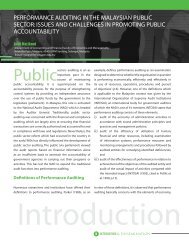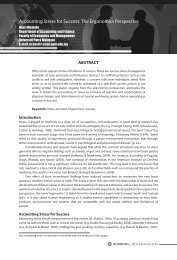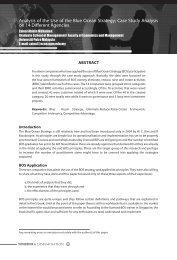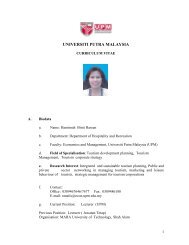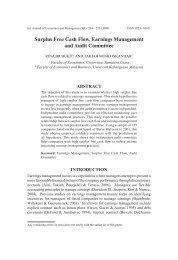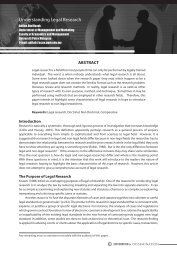KOOLKES SENDIRIAN BERHAD: How Cool Can The Fridge
KOOLKES SENDIRIAN BERHAD: How Cool Can The Fridge
KOOLKES SENDIRIAN BERHAD: How Cool Can The Fridge
You also want an ePaper? Increase the reach of your titles
YUMPU automatically turns print PDFs into web optimized ePapers that Google loves.
C A S E 4Asian Journal of CaseResearch1(2): 144 – 162 (2008)<strong>KOOLKES</strong> <strong>SENDIRIAN</strong> <strong>BERHAD</strong>: <strong>How</strong> <strong>Cool</strong> <strong>Can</strong><strong>The</strong> <strong>Fridge</strong> Be?AZIZI ALI a *, ZAINAL ABIDIN MOHAMED b AND NG SUET FONG cABSTRACTThis case traces the background behind the establishment of KoolKesSendirian Berhad, a Malaysian company dealing with refrigerateddisplay showcase equipments, its involvements in the industriesconcerned, its management, its business activities (products / services,suppliers, customers, etc.) and strategies (marketing, competitors,challenges / opportunities, present and future plan, etc.) and also thegeneral perspective for the industries which the company is involvedwith. Although a lot of factors, both internal and external, local andglobal, affect and tremendously impact the company’s progress andachievements, the main industries which KoolKes Sdn. Bhd. is dealingwith remain prominent and the company will be here to stay.Keywords: Refrigerator equipment, strategy.INTRODUCTIONOn May 22, 2004, Mr. P. K. Gong, the Managing Director of KoolKes, puffedthoughtfully on his pipe as he gazed out from his office window. Just minutesago, he was on the phone with his long-time friend Mr. Freddy Sim, fishing forsome information about Carrefour’s giant project in Penang, estimated to be worthabout RM2.1 million.aFaculty of Economics and Management, Universiti Putra Malaysiab&cGraduate School of Management, Universiti Putra Malaysia*Corresponding author: Email: azizi@econ.upm.edu.my, Phone: 603-89467766This case was originally written by Ms. Ng Suet Fong and an MBA student from Graduate Schoolof Management (GSM). It has been modified for classroom purposes by Azizi Ali and Zainal AbidinMohamed from the two authors; the latter also being their supervisor. <strong>The</strong> case is not meant as anindication for any right or wrong decision but only to be used for training purposes on managementissues pertaining to the case and related industry. [GSM/UPM July 2007].144
Koolkes Sdn Bhd: <strong>How</strong> <strong>Cool</strong> <strong>Can</strong> the <strong>Fridge</strong> Be?“I think there’s a fat chance that Carrefour would awardthe project to Hussmann. You know, their quotation is moreattractive than yours,” said Mr. Freddy Sim.“Yes, but what is RM 50,000 to them? Everyone knows thatKoolKes can provide a better after-sales services and we don’tcut corners just to lower the price!” Mr. P. K. Gong protested.Mr. P. K. Gong sighed with disappointment as he recalled the conversation.“Looks like another missed opportunity for KoolKes.”His thoughts continued:Business at KoolKes has been slow since early this year whenthe economic downturn began to take its toll. So far, KoolKeshave only managed a small project. Unlike the rapid growthin the food retail industry between 1998 - 2003, the industryis now growing at a slower pace. <strong>The</strong> demand for importedhypermarket and supermarket refrigerated display showcaseand other related products has stagnated following the currencyexchange instability in 2003 and is anticipated to continue inthe near future. Many new projects by big food corporation inthe country have been shelved indefinitely. This is indeed verybad.He took a deep breath and shook his head. <strong>The</strong> declining business caused Mr.P. K. Gong to ponder on the future of KoolKes.I wish I know exactly what to do.Mr. P. K. Gong knew that the national economy would still slowly recover inthe next few years. He was also aware that the future of KoolKes would be bleakif drastic measures are not immediately implemented to improve business duringthis critical period.I must find some solution quickly before all my resources aredepleted. <strong>The</strong> Maybank Finance Manager and the BBMBManager wanted to meet me next week. Could it be that theywant to review KoolKes’s existing loan repayment? Or could145
Asian Journal of Case Research (AJCR)it be that the new loan application for KoolKes is rejected?Where can KoolKes turn to if the banks can no longer give theirsupport?<strong>The</strong>se questions kept reeling at the back of Mr. P. K. Gong’s mind. He had tomake a strategic proposal and come up with some specific recommendations forthe next board meeting within a week’s time.BACKGROUND OF THE COMPANYKoolKes Sdn. Bhd. was established in February 2000 with an authorized capitalof RM500,000 and a paid-up capital of RM300,000. Its shareholders were Mr.P. K. Gong and Mr. S. P. Han, who were respectively the company’s ManagingDirector and Technical Director. Mr. P. K. Gong also became the company’sacting Sales and Marketing Manager. <strong>The</strong>y both previously served withElectrolux Commercial Products Sdn. Bhd. for 10 years. Mr. P. K. Gong beganas a Sales Executive, got promoted as a Sales Manager, then as Product Managerand later became a Divisional Manager there. Mr. P. K. Gong handled projectsfor major supermarkets and specialty stores (e.g. Parkson, Kerry, Jusco andAyam Dindings) during his tenure with Electrolux. In contrast, Mr. S. P. Hanstarted as a senior Services Technician and later became a Service Manager cumRefrigeration Specialist for the company. He was also involved with projects formajor supermarket like Isetan, Sogo, Parkson, Giant, Ocean and others. Whileworking for Electrolux, they shared a dream to set up their own company and tobe the leader in the market for supermarket equipments supplies.Koolkes’s sales office was located in Ampang, Kuala Lumpur. KoolKeshad a factory lot approximately 8,000 square feet in Sungai Buloh industrialarea. It was used to store goods in transit to customers but most of the time therefrigerated showcases were delivered to the site directly. <strong>The</strong> principal activityof KoolKes was store designing, supplying and installing imported commercialrefrigerated showcases in food retail outlets such as hypermarkets, supermarkets,mini markets, convenience stores and specialty stores. KoolKes also providedafter - sales support, training and maintenance services and consultancy.“Our mission is to be the superior equipment supplier forthe food retail stores in Malaysia. To achieve this, we haveto be professional and equipped with comprehensive technicalknowledge and skill. We must offer a good range of qualityproducts and have both efficient and reliable back - up services,”said Mr. P. K. Gong to his employees in a company meeting inthe first year of KoolKes’s establishment.146
Koolkes Sdn Bhd: <strong>How</strong> <strong>Cool</strong> <strong>Can</strong> the <strong>Fridge</strong> Be?PRODUCTS AND SERVICES“Sales for equipments made up about 60% of the turnoverwhilst the other 40% comprised of installations, after-salesservices and consultations for store planning and systemdesign,” explained Mr. P. K. Gong. “We sell various typesof showcase equipments as well as evaporators, compressorsand spare parts. We have different brand names from severalcountries, too.”ProductsAccording to Mr. P. K. Gong, refrigerated display showcase equipments hadimproved over the years into newer, better designs with attractive and more costeffectivefeatures, namely their energy-saving system. Manufacturers continuouslyupgrade their products through research and development to produce high qualityequipments at competitive prices. A wide range of designs at various sizes wasmade available to satisfy the different needs of customers. <strong>The</strong> most importantcharacteristics which customers looked for in the equipments are low energyconsumption and minimal maintenance requirements. Environmentally friendlyrefrigeration such as the R22 freezer system are preferred and used extensivelyby food retail outlets. Showcases may be used for about 10 years if they wereproperly maintained. (<strong>The</strong> product details are in Appendix 1.)Showcases mainly had two distinctive designs; European and Japanese /American designs. In Mr. P. K. Gong’s opinion, European-designed showcaseswere very modern in appearance, used a lot of glass, with low front endings andlarge display areas. <strong>The</strong>y were particularly suitable for hypermarkets as theyhave the space for displaying voluminous sales. <strong>The</strong> Europeans, in particular theFrench, started the first hypermarket in 1968 in Paris through Carrefour. Europeanmanufacturers of refrigerated showcases started designing their equipments forthis purpose as the idea for hypermarkets originated there.As for the Japanese/American designs, they were very traditional in designand they catered only for the supermarkets. <strong>The</strong> reason for the similarity indesign for the Japanese and the American showcases dated back to the 1950’s.<strong>The</strong> American showcases such as Hussman’s and Tyler’s were made in Japanunder contract manufacturing as the production cost was much lower than theU.S. Moreover the showcases can be shipped easily to the Far East, Australiaand the U.S. Food retail businesses in the U.S. were mainly conducted throughsupermarkets, contrary to Europe. Meanwhile, different trends in food retailbusinesses in Asia is increasing rapidly.147
ServicesAsian Journal of Case Research (AJCR)Mr. Han, the Technical Director, said that a wide range of support and serviceswere available for customers for the installation of equipments and for developingtheir maintenance’s self–sufficiency. <strong>The</strong> support and services according to Mr.Han included:a. Sales support – <strong>The</strong> sales team of KoolKes worked closely with thecustomers in the project. This served to better coordination and utilizationof resources of the two parties and provided a two-way feed back. Suchsales support activities included equipment appreciation, coordinatedtraining and customer’s maintenance services.b. Training support – Following installation, KoolKes would provide “AUser Training Program’’ to assist customers to quickly familiarize withthe equipment and become self – sufficient.c. Maintenance support – KoolKes would provide the customers with thenecessary spare parts and labor (without extra cost) and would attend toany breakdown of equipment for a period of 12 months from the date oftesting and commissioning. No income was generated from the aboveactivities.When the warranty period expired, the customers could opt for KoolKes’smaintenance and repairs services as described below:a.b.Twelve monthly preventive maintenance services to check on installedequipment (annual maintenance contract).Availability for 24 hours breakdown services.KoolKes offered a 2 month guarantee for each repair job, againstmanufacturing defect, on spare parts replaced and workmanship,excluding excessive wear and tear, negligence, damages resulting fromlightning, flood etc.<strong>The</strong> maintenance services were paid as follows:a.b.Annual maintenance charges payable in advance upon signing ofcontract.Breakdown services charges at special predetermined prices on laborand spare parts.Refrigerated display showcase equipment just like any other equipmentrequired good after-sales services and maintenance services to prolong the serviceslife of the equipment. Repairs during breakdowns were costly not to mention thelosses incurred due to food spoilage, opportunity costs, disrupted operation andcustomers dissatisfaction.148
Koolkes Sdn Bhd: <strong>How</strong> <strong>Cool</strong> <strong>Can</strong> the <strong>Fridge</strong> Be?In KoolKes, the service team underwent external training to increase skilland knowledge of products and also attended seminars on public relations. Onthe-jobtraining was provided by Mr. S. P. Han. Mr. P. K. Gong who had made itclear to his employees over and over again that good customer service was vitalto KoolKes and must be provided at all times. This was because maintenanceservices generated substantial income for the company upon the expiration ofthe warranty period. Mr. P. K. Gong often stressed that it was important to signup maintenance contract with customers as each contract would ensure incomefor company for a minimum period of twelve months. With the large base ofmaintenance contract, the income generated would thus make the servicesdepartment’s operation profitable. Mr. P. K. Gong believed that KoolKes, withits good customer’s services and high technical skills, could be placed in a betterposition amongst its competitors.CUSTOMERS<strong>The</strong> hypermarkets in Malaysia are operated by a mix of both foreign and localcompanies. European hypermarket operators like Carrefour from France andMakro from Holland have already been operating for some time here. Carrefourhas four hypermarkets which are located in Subang Jaya, Johor Bahru, WangsaMaju and Sri Petaling. <strong>The</strong> company’s latest outlet in Penang will be ready forbusiness by December 2004. Macro presently has six outlets which are locatedin Shah Alam, Selayang, Seremban, Johor Baru, Ipoh and Seberang Prai. Its nextoutlet in Cheras will begin operation by December 2004. On the other hand,Extra, Giant and Fajar are Malaysia’s local hypermarket operators. Extra has atotal of six hypermarkets located at Mines Shopping Fair (Seri Kembangan), UEP,Ipoh, Klang, Johor Bahru and Melaka; Giant’s hypermarkets are located in USJ,Permata and Johor Bahru while Fajar’s only outlet is in Cheras.Supermarkets are mainly owned by Malaysians. Some of them have jointventures with foreign companies: Isetan, Jaya Jusco, Yaohan and Sogo were suchexamples of Japanese joint ventures with Malaysian partners. Cold Storage wasoperated together with Dairy Farm of Hong Kong under the Welcome Stores.<strong>The</strong> Dutch’s Royal Hold and Kuok Group were operating their stores underTops. Tops took over the supermarkets division of Parkson on July 7, 2000 andthis division would be fully operating under the format of Tops in October 2000(Source: the Sun, 7 July 2000). By this acquisition, Tops had become the leadingsupermarkets chain in Malaysia with a total of 47 outlets. <strong>The</strong> Store had a totalof 26 supermarkets. Other local operators were Fajar, Ocean and small-familyoperated stores as TC Permata, Bintang , Warta and Hong Kong.Mini markets were mainly operated by locals and were located at housingestates, small towns and suburbs. <strong>The</strong>y only used self contained chiller cases withheated glass doors for the dairy and fruit juice products. <strong>The</strong> larger mini marketsnormally would have an island chiller or freezer and a freezer cold room.149
Asian Journal of Case Research (AJCR)<strong>The</strong> convenience stores are mainly located at petrol stations were ownedby multinational companies such as Shell (Select), BP (Kedai), Mobil (MobilMart) and Esso (Tiger Mart), with the exception of Petronas (Mesra) which wasMalaysian-owned. <strong>The</strong> 7-Eleven convenient stores were not related to the oilcompanies but were locally owned by Antah Holdings. <strong>The</strong>y were located inhousing estates and near big hotels in the cities. <strong>The</strong>se convenience stores useda fair number of self contained chiller cases with heated glass doors and islandfreezers for their ice cream products.SUPPLIERS“This company has two different suppliers of refrigerateddisplay showcase equipments for fulfilling customers’requirements. Our market is of a considerable size and we havebeen a regular supplier for Japanese-owned stores. Koolkes’customers include Isetan, Yaohan, Sogo and Jaya Jusco. Thisparticular group of customers will only purchase Japanesemadeequipments and because of this, KoolKes has acquiredthe agency rights for importing, distributing and installingSanyo’s refrigerated display showcase equipments in Malaysia.Sanyo is the biggest manufacturer of showcases in the worldand it supplies almost 40% of the refrigerated showcases soldin the Asian region with 18, 000 cases per year. It has been inMalaysian market since 1983 and its product has proven to bereliable,” said Mr. P. K. Gong to a potential customer.As the next target group of customers comprised the Europeans andMalaysians, KoolKes secured the agency rights to Costan (Appendix 1) from Italyto meet the requirements of this group of customers. Costan also supplied selfcontaineddisplay cases targeted for convenience stores.“Costan had its Asian office in Manila since 1993 and wasamong the top five manufacturers of showcases in Europe.It had sold quite substantially in the Philippines, China andSingapore and was working closely with KoolKes to broadenits market shares in Malaysia which was now dominated byBonnet Neve and Linde as far as European-made showcaseswere concerned. Costan had showed interest to manufacturesome showcase components and eventually whole showcasesin Malaysia. It has been on the lookout for a partner in thisventure of manufacturing showcases. Beginning with theself-contained cases and later on to the high–tech multi-deck150
Koolkes Sdn Bhd: <strong>How</strong> <strong>Cool</strong> <strong>Can</strong> the <strong>Fridge</strong> Be?refrigerated showcases,” deliberated Mr. Han when explainingthe various suppliers.COMPETITORSAccording to a salesman, the market for refrigerated display showcase equipmentsis very competitive. Electrolux and Hussmann (see Appendix 1) were the marketleaders in Malaysia from 1987 to 2000 and used to represent their parent companies;each for Swedish and American manufacturers respectively. <strong>How</strong>ever during aperiod in 2000, the exchange rate for the Swedish Kroner and the U.S Dollarincreased in comparison to the Malaysian Ringgit. As a result, Electrolux insteadmarketed equipments made by Fukushima of Japan and Hussmann had its casesmade by Nakano, also from Japan. Both products were branded respectively asElectrolux and Hussmann, as it was much cheaper for the companies to buy fromJapan rather than their home countries.In 1992, Bonnet Neve from France entered the Malaysian market throughLeading Refrigeration Sdn. Bhd. and in 1993, T. M. <strong>Cool</strong>ing Technology Sdn. Bhd.became its distributor until 1994. It was then marketed by Zenick EngineeringSdn. Bhd. <strong>The</strong> salesman also explained that entry of Bonnet Neve was verytimely as the rate of France Franc was low and stable then, thus it managed tocontrol 30% of the market for refrigerated showcases equipments. Bonnet Neve,unlike Electrolux and Hussmann, only worked using its local representatives forsales and installation and also provided engineering expertise. <strong>The</strong> companyhad sales representative’s offices in Singapore and South Korea to cater for itslocal representatives all over Asia. It had plans to have its refrigerated showcaseequipments assembled locally and eventually to have them manufactured here.Bonnet Neve’s production of showcases was about 30,000 cases a year and 7,000of these were exported to Asia annually.<strong>The</strong> lead time from the date of order until delivery to customers would takeapproximately 90 days, including shipping which would require about 4 weeksfrom France to Asia. Bonnet Neve was scouting for a local company for a jointventure in this project in Malaysia. <strong>The</strong> strategic position of Malaysia in Asiawould mean that shipment will be faster and this will translate to earlier delivery.Manufacturing time would be reduced and hence, prices of the refrigeratedshowcases will be greatly reduced as the costs of labour, freight, warehousingand inland transportation were lower. Bonnet Neve was also waiting to takeadvantage of ASEAN Free Trade Area (AFTA) as it would benefit substantiallyfrom the reduced taxes and thus, would make its products price very attractive.Linde from Germany also made its appearance in the market scene in 1992with its first Asian sales representative office based in Hong Kong. <strong>How</strong>ever,Linde practiced direct sales to supermarket owners and its local representativesonly carried out the installations, warranty and after-sales services. From 1992 to151
Asian Journal of Case Research (AJCR)1996 its local representatives in Malaysia was United Refrigeration Sdn. Bhd. butwas replaced by Hub’s Engineering Sdn. Bhd. since 1996.Other competitors were Arneg from Italy, represented by Kong ChuanRefrigeration Sdn. Bhd., Croisbanc from Italy, represented by SommervilleMalaysia Sdn. Bhd. and Kohxa from Spain, represented by Chief, themanufacturer itself.<strong>The</strong> frequent changing of local representatives by reputable and big suppliers,such as Bonnet Neve and Linde, were mainly because local representatives couldnot meet their high technical standards. As a result, the suppliers lost their salesas the local representatives’ after-sales services and customer service were weakand unsatisfactory.<strong>The</strong> number of competitors grew as the food retailing industry expanded.<strong>The</strong> Malaysian society became more affluent and advanced and this changed theirshopping patterns. Shoppers preferred convenience when shopping and a onestop-shop suited their needs. Mr. P.K. Gong noted,“Families nowadays would want to go to shopping complexeswhere they can shop at the department stores, eat at the foodcourt or restaurants, see movies at the cinema complexesand get their groceries at the supermarket, all in a visit – howconvenient! <strong>The</strong> society has also become more health consciousand preferred hygienic and safe practices in food handling andstorage found in refrigeration system.”MANUFACTURING<strong>The</strong> manufacture of refrigerated display showcase equipments with remotecondensing system such as multi-deck and island chiller/freezer display showcasesdiffer greatly from self-contained (condensing unit) chiller cases with heated glassdoors. <strong>The</strong> former required high technology and R&D to get the correct flowof refrigerated air in cooling the display cases with a minimal loss of coldnessand lower energy consumption. Incorrect designs for their airflow curtains maycause warm air and dust to be trapped inside the showcases. As a result, watercondensation may happen within the showcases and cooling efficiency will bereduced. <strong>The</strong>se cases must be acclimatized to local conditions (different ambienttemperature, humidity, etc.) for optimum performance. Airflow curtain designshowever, were not required for the self-contained chiller cases as the heated glassdoors prevented the cold air from leaving the cases.Remote condensing system was used mainly in hypermarkets and supermarketsbecause these outlets required a huge number of refrigerated showcases. With itscondensing system comprising of several compressors located in the compressorroom or outside the building, heat generated from the condensing system would152
Koolkes Sdn Bhd: <strong>How</strong> <strong>Cool</strong> <strong>Can</strong> the <strong>Fridge</strong> Be?be away from the customer area in the hypermarkets or supermarkets. Selfcontaineddisplay cases were largely used in mini markets, convenience storesand specialty stores. Heat generated from the condensing units of these cases waslower because the condensing units consumed lower energy.A Koolkes technician had said that,“<strong>The</strong> manufacturing of refrigerated display cases usingthe remote condensing system also require a large capitalinvestment. On the other hand, the self-contained chiller casescould be manufactured locally at a very low cost. <strong>The</strong> blowerfan, cooling coil and insulated chassis can be made or sourcedlocally. Only the heated glass doors would have to be importedfrom Taiwan. <strong>The</strong> condensing unit can be fitted with locally madeparts and the refrigeration unit (compressor) can be importedfrom Taiwan. <strong>The</strong>se self- contained chiller cases had a veryhuge market in Malaysia for the mini markets and conveniencestores. With a cheaper price from local manufacturers, it wasnow possible to have a sizeable volume of sales as it was mademore affordable for customers.”PRICE FACTORS<strong>The</strong> prices varied greatly from year to year due to the changing exchange rates offoreign currency as most of the refrigerated showcase equipments’ suppliers camefrom Europe, Japan and America. In the early 90’s, the value of Yen and U.S.Dollar appreciated, thus increasing the cost for display showcases equipmentsfrom Japan and America. At the same time, the value for European currencieswere much lower, thus making their products more competitive. It was duringthis time that the European manufacturers, such as Bonnet Neve, Linde, Arneg,Croisbanc and others, were able to break into the Malaysian market which wasonce dominated by Japanese and American brands.In most cases, the price of the equipment was the deciding factor for a deal tobe concluded by local supermarket operators. <strong>How</strong>ever, Japanese-owned storessuch as Jaya Jusco, Sogo, Isetan and Yaohan preferred Japanese-made showcasesregardless of the cost of equipment. As for the European operators, like Carrefourand Makro, they preferred European design showcases mainly because of thehypermarket specifications which only European manufacturers could satisfy.<strong>The</strong> recent currency exchange rate instability had affected the cost of theimported showcases to a great extent.“Now, because of the high exchange rates, the refrigerationequipment costs even more and this make it even harder for153
Asian Journal of Case Research (AJCR)KoolKes to sell!” Mr. P. K. Gong grumbled to Mr. S. P. Hanupon checking the exchange rates with his banker.In July 2003, the exchange rates of Ringgit to U. S. dollar were 2.5, Ringgitto Sterling Pound 3.2 and Ringgit to Yen were 2.10 ( Per 100yen) but these hadincreased to 4.2, 6.8 and 3.0 respectively.<strong>The</strong> market prices for the various refrigerated display showcases importedinto the country are shown in table 1.Table 1 Market PriceType Size Price (RM)Multi deck Chiller/ FreezerDisplay Showcase8’12’Island Freezer Display Showcase 4’8’12’Service Counter Display Showcase 8’12’Self contained Chiller Case (with heated glass Doors)2’ (1 door)4’ (2 door)6’ (3 door)21, 000 – 23, 00026, 000 – 28, 00012, 000 – 16, 00018, 000 – 22, 00025, 000 – 28, 00018, 000 – 22, 00024, 000 – 26, 0004, 5006, 0007’ 000N.B.: <strong>The</strong> current market price of the cases in Table 1 had increased by approximately 60% of theprices listed above. This was because in addition to the currency depreciation of about 40%, there wasalso an increase in freight and insurance costs which were quoted in U.S. Dollar and thus increase theduties payable for imported goods.Installation per foot-run copper piping, insulation and wiring would costabout RM 220 per foot-run. Electrical control panels depending on the numberof showcases and refrigeration system (number of compressors) could cost fromRM 30, 000 to RM 120, 000.This would bring about less than RM 5, 000 for the sale of a simple equipmentfor small outlets to a few million ringgit for big projects involving hypermarketsor supermarkets.MANAGEMENT AND PERSONNELKoolKes’s organization started expanding since the company’s establishmentwhen it only comprised of four employees; a technician, an apprentice and twoclerks. By May 22 1998, the company had twelve employees. <strong>The</strong> organizationalstructure of the company is given below in Figure 1.154
Koolkes Sdn Bhd: <strong>How</strong> <strong>Cool</strong> <strong>Can</strong> the <strong>Fridge</strong> Be?ManagingDesign & DrawingDept3. DraughtsmanSales & MarketingDeptMarketing ManagerProject cum ServiceDept TechnicalAdministration cumAccounts Dept1. Sales Manager2. SalesRepresentative1. Project Executive2. Service1. General ClerkFigure 1 <strong>KOOLKES</strong> Sdn. Bhd. Organisation ChartMr. P. K. Gong assumed the dual role of Managing Director as well asSales and Marketing Manager. His duties included meeting customers, seekingnew projects, coordinating existing projects, dealing with supplier and trainingemployees, among many others. At times, he wished for middle-level managersto whom he can delegate the managing, planning and performing of more specifictasks within KoolKes. His business partner, Mr. S. P. Han, was the TechnicalDirector.Mr. P. K. Gong always believed good marketing skills and sound technicalsupport were crucial to his business. Thus, he and Mr. S. P. Han spent much effortin training and motivating their staff and maintaining them in the company.“Skilled and dedicated employees are hard to come by. <strong>The</strong>yare valuable assets to a company. When you have them, keepthem as long as you can.”Mr. P. K. Gong had always said this to Mr. S. P. Han. This was reflected onthe low staff turnover – only one servicing supervisor had resigned in the span offour years.<strong>How</strong>ever, Mr. S. P. Han had indicated to Mr. P. K. Gong that his technical andservices staff were struggling with the increasing workload and worried that thequality of work would be affected.“We need to expand our workforce especially in the Servicesand Marketing Division. A few good projects were turned downbecause we know we would not be able to cope and completethem on time. <strong>How</strong>ever, that was in the past when the economywas good and KoolKes had not maximized its business becauseof limited manpower. Today, the business scenario dictates155
Asian Journal of Case Research (AJCR)that we should be all the more aggressive in competing withothers projects. We really need a full time Marketing Managerwho could bring in more projects for KoolKes,” Mr. S. P. Hanfurther commented.PERFORMANCE AND FINANCEAccording to Mr. P. K. Gong, the company’s profitability was only fair in its fouryearsestablishment, taking into account that it was new and thus, would requiremore time to break into the business and gain customers’ confidence. Please referto Table 2: (<strong>The</strong> company’s balance sheet and the profit-and-loss statement areincluded in Appendix 2 and Appendix 3)Table 2 Company’s ProfitabilityFinancial Year 2001 2002 2003Turnover (RM) 3, 282, 217 3, 819, 625 4, 871,777Profit before tax (RM) 13, 923 20, 51 38, 907Profit after tax 4, 923 13, 519 25, 227KoolKes’s initial profit was from sales and installations of showcases whichwas a one-off event. <strong>The</strong> real fixed income would roll in when the warrantyperiod of the equipment (12 months) expired and a maintenance services contractwas made. Higher sales of equipment would translate to a bigger maintenancecontract volume which will then be an assured income as long as the refrigeratedshowcases were operational.KoolKes was given a letter of credit facilities of RM 1 million from its bankershould the company need to import equipments for its projects. Its suppliers alsoprovided a 90-day term credit of RM 1 million for showcases to help KoolKesmanages the fund from the date of order to installation before customer paymentwas due.GOVERNMENT POLICIES AND REGULATIONS“<strong>The</strong> equipments won’t be so costly if not were for the highimport duties,” Mr. S. P. Han had one day commented to Mr.P. K. Gong.“True, but there’s nothing we can do about it. It’s thegovernment’s policy,” said Mr. P. K. Gong. “Let us hope thatin the near future, Malaysia will be able to manufacture andexport the equipments, especially to ASEAN countries when156
Koolkes Sdn Bhd: <strong>How</strong> <strong>Cool</strong> <strong>Can</strong> the <strong>Fridge</strong> Be?the market expands with AFTA. <strong>The</strong>n, the import duties wouldbecome irrelevant and more people are able to afford theshowcases,” he continued.<strong>The</strong> government of Malaysia as well as of the other ASEAN countries imposedduties of approximately 40% for imported refrigeration equipment for a numberof reasons. This policy was mainly to encourage local manufactures to go into theproduction of refrigeration equipment and to protect Malaysia-made refrigerators,chillers and freezer cases for coffee shops and restaurants. <strong>The</strong> government alsoencouraged assembly of the refrigerated display showcases locally and eventuallymanufacturing it. This had not materialized yet because to take up such task,the manufacturer would need a big production volume and large investment inresearch and development to make the venture a success.“At this moment, manufacturers such as Costan and BonnetNeve though keen to invest in Malaysia are wary of the largeinvestment in R & D needed for the set-up of the plant,” saidMr. S. P. HanAs the ASEAN governments intended to implement AFTA latest by 2003(source: <strong>The</strong> Sun, July 18, 2004), this would provide an opportunity to the localmanufacturing industry as it would allow access to a larger market at competitiveprice. <strong>The</strong> duties within ASEAN countries would be 5% (sales tax included).<strong>The</strong> Malaysian government strongly encouraged joint-venture between SMI(Small and Medium-sized Industries) manufacturing companies with foreigncompanies to make the industry feasible. <strong>The</strong> Government was aware that it wascostly to continue importing refrigeration equipments and by manufacturing itlocally, the country‘s foreign exchange would be reduced and this was very muchneeded during the economic downturn. <strong>The</strong> government adopted the policy todiscourage imports of goods while encouraging exports.“Looks like there’s a strong possibility of manufacturing theshowcases locally in the future. If we can produce the equipmentat a reasonable cost and quality, we can help the country tosave some foreign exchange,” Mr. P. K. Gong concluded histalk with Mr. S. P. Han.Malaysian Industrial Development Authority (MIDA), a government agency,provided tax incentives or relief for those wishing to set up factories underthe conditions that they must employ at least 75 workers, export 80% of theirproduction or invest at least RM 2 million in the business.157
Asian Journal of Case Research (AJCR)PRESENT AND FUTURE SITUATIONWith the present depressing market situation, most food retail outlets, includingKoolkes’s customers, are compelled to reduce their expenses and increasetheir business opportunities at the same time without spending more for capitalequipments. <strong>The</strong>y will not buy any new equipments unnecessarily. <strong>The</strong>refore,customers mostly sought for after-sales services in maintaining their presentequipments. Most of the projects available are being postponed or completelycancelled as financing facilities were not provided by local banks and financialcompanies. Available bank loans are charged with high interest rates. Any projectsto be realized must be internally funded, which is only possible for family-ownedstores or foreign operators who bring their own funding into the country.“Only hypermarket giants such as Makro and Carrefour couldstill plan new outlets in Malaysia. <strong>The</strong>y are our only hope.Others that need support from our local banks don’t standa chance, not at this moment. Also, with the market gettingsmaller, the competition to secure new projects is much stiffernow than ever,” Mr. P. K. Gong commented during a meetingwith the marketing director of Costan.<strong>The</strong> refrigerated display showcases were totally imported and payment mustbe made in advance to supplier before any shipment can be made. <strong>The</strong> equipmentwas costly and without the support from the banks or finance companies, itwould not be possible for the local operators to purchase new equipment for theirprojects.THE FOOD RETAIL INDUSTRY – AN ASIAN PERSPECTIVE<strong>The</strong> June 2004 edition of the Asian supermarket magazine reported that currencyinstability had badly affected the food retail industry in Asia. In countries underthe IMF (International Monetary funds) bailouts such as Indonesia, Thailand,South Korea and to a certain extent, the Philippines, imports were no longerpossible. <strong>How</strong>ever, the existing hypermarket and supermarket, especially thosewhich were involved with perishables and foodstuffs, were able to maintain theirbusiness.In spite of the recession, the hypermarkets and supermarkets would continueto survive as they dealt with foods and groceries, which would no longer beimported but sourced locally. During difficult time, people would spend onnecessities for which food was the most important.158
Koolkes Sdn Bhd: <strong>How</strong> <strong>Cool</strong> <strong>Can</strong> the <strong>Fridge</strong> Be?“Thank God that despite the economic crisis, there is stillpolitical stability in this country and this would allow thefood retail industry to ride through the recession and perhaps,experience a minimal growth,” commented Mr. P. K. Gong.<strong>The</strong> European hypermarket operators such as Carrefour, Makro, Royal Ahold,Continent and Casino were all moving into Asia. In Malaysia, Carrefour and Makrowere interested in establishing new outlets. Among the factors that influenced thisventure were low cost of start-up operations (i.e. property value had gone downin price), availability of cheap labour, a large and growing population that wouldprovide a potentially attractive market, appreciation of the foreign currencies overthe Asian currencies and no restriction on total ownership of their business if theywould bring in funds and invest in the host country. <strong>How</strong>ever, the Philippines wasnot in the list as regulations forbade foreigners to set up stores so as to supportand protect their own companies from strong competition from foreign ownedcompanies.“<strong>The</strong> population growth rate in Malaysia and several otherASEAN countries is about 2.5% per year. This provides a goodprospect for the food retail industry and companies like ours,”Mr. P. K. Gong commented to a customer.<strong>The</strong> leading British food retailer, Tesco had taken advantage of opportunitiescreated by the Asian economic crisis by buying into one of Thailand’s keyhypermarket chains. <strong>The</strong> deal with Lotus encompassing 13 hypermarkets, wouldnot have been possible under normal economic conditions. Tesco planned todouble the number of Lotus stores in the next four years. <strong>The</strong> deal also allowedTesco to enter other Asian markets including China where there were already 2Lotus superstores with 3 others scheduled to be opened in 2004. Lotus planned toopen 50 more Lotus hypermarkets in China over the next 10 years.Carrefour had 24 hypermarkets in Asia with new openings in South Korea,Thailand, Hong Kong and Malaysia. Taiwan was Carrefour’s first Asian marketwhen it entered the region in the late 80’s and had 18 outlets opened to date.Worldwide, the Carrefour hypermarkets numbered 275 (179 in Europe, 72 inAmerica and 24 in Asia).<strong>The</strong> retail industry in Indonesia, after the devastating rioting and looting inmid May 2004, with 43 stores burned to the ground and 53 stores looted anddamaged, suffered an estimated loss of US$ 413 million. <strong>The</strong> industry would takeseveral years to be restored.159
Asian Journal of Case Research (AJCR)EPILOGUE:Having had the opportunity to analyse the industry and the national environment,Mr. P. K. Gong needed to call some of his senior staff to gather some ideas so thathe will have some basis for what he would present in the boardroom, especiallywith the types of analysis which the board members would like to see before theycome up with some strategic decisions. He needed to call them by tomorrow asthere was only four days before the board meeting.APPENDIX AList of Products Sold and <strong>The</strong> Brand Names.<strong>The</strong> products offered by KoolKes were mainly refrigerated display showcase equipmentsuch as:i. Multideck Wall Chiller / Freezer display Showcaseii. Island Chiller /Freezer Display Showcaseiii. Service Counter Display Showcaseiv. Self-contained Chiller Cases<strong>The</strong> others were evaporators, compressors and spare parts of the refrigeration system.<strong>The</strong> product brand names were:i. Sanyo - Japan (Exclusive agency products), showcaseii. Costan - Italy (Exclusive agency products), showcaseiii. New Mc Air - Local supplier ( Free market ), evaporatorsiv. DWM Coupeland - Germany ( Free market ), compressorsv. Electrolux - Sweden, showcasevi. Hussman - USA, showcasevii. Bonnet Neve - European (France), showcaseviii. Linde - European (Germany), showcaseix. Fukushima - Japan, mixedx. Nakano - Japan, showcasexi. Arneg - Italy, showcasexii. Crosbanc - Italy, showcasexiii. Kohxa - Spain, showcase160
<strong>The</strong> Company’s Balance Sheet.SHARE CAPITALAuthorised: 500,000 ordinary shares of RM 1eachIssued: 300,000 ordinary shares of RM 1 each,fully paidKoolkes Sdn Bhd: <strong>How</strong> <strong>Cool</strong> <strong>Can</strong> the <strong>Fridge</strong> Be?APPENDIX B2001 2002 2003500,000.00 500,000.00 500,000.00300,000.00 300,000.00 300,000.00Profit brought from P and L Account 4,923.22 18,442.22 43,669.93LONG TERM LIABILITIESSub total 204,923.22 318,442.22 343,669.93Hire purchase creditors 28,758.00 37,500.25 187,290.81Bank Loan 115,815.09 106,533.24Sub total 233,681.00 471,757.56 637,493.98FIXED ASSETS 117,618.00 470,468.48 724,239.01CURRENT ASSETSStock and work-in-progress 193,828.00 467,653.08 938,199.45Trade debtors 92,986.00 292,367.40 978,841.20Other debtor and sundry deposits 9,300.00 7,230.00 169,258.55Cash at banks and in hand 74,126.00 15,758.53 143,858.60Sub Total 523,738.00 783,009.01 2,230,157.80CURRENT LIABILITIESTrade creditors 77,850.00 371,899.45 1,365,666.58Advances received on contract 300,808.00 208,300.00 850,386.10Accruals 7,942.00 65,200.00 6,000.00Hire purchase creditors 12,075.00 19,244.00 62,950.75Amount owing to directors 1,985.80Bank loan 6,300.00 6,300.00Bank overdraft 94,776.48Taxation 9,000.00 16,000.00 23,613.60Sub Total 407,675.00 781,720.00 2,316,902.83NET CURRENT ASSETS 116,063.00 1,289.08 - 86,745.03161
Asian Journal of Case Research (AJCR)APPENDIX C<strong>The</strong> Company’s Profit and Loss Account.2001 2002 2003Turnover 3,282,216.77 3,819,624.00 4,871,776.75Profit before taxation 13,923.00 20,519.00 38,906.71After charging/ (crediting):Directors’ salary, bonus and EPF contribution 61,480.00 141,173.00 134,633.00Directors’ fee 60,000.00Rental and premises 42,000.00 25,160.00 36,788.00Audit 4,800.00 5,200.00 6,000.00Hire of tractor and crane 1,700.00Hire purchase interest 1,929.00 3,170.00 7,526.31Bank loan interest 5,391.34 10,581.15Preliminary expenses written off 4,618.00Depreciation on fixed assets 13,069.00 181,830.21 51,954.61Fixed deposit interest received -14,850.00 -8,229.64Less taxation -9,000.00 -7,000.00 -13,679.00Profit after taxation 4,923.00 13,519.00 25,227.71Unappropriated profit brought forward fromprevious year4,923.20 18,442.22Un appropriated profit carried forward 4,923.00 18,442.22 43,669.93162


